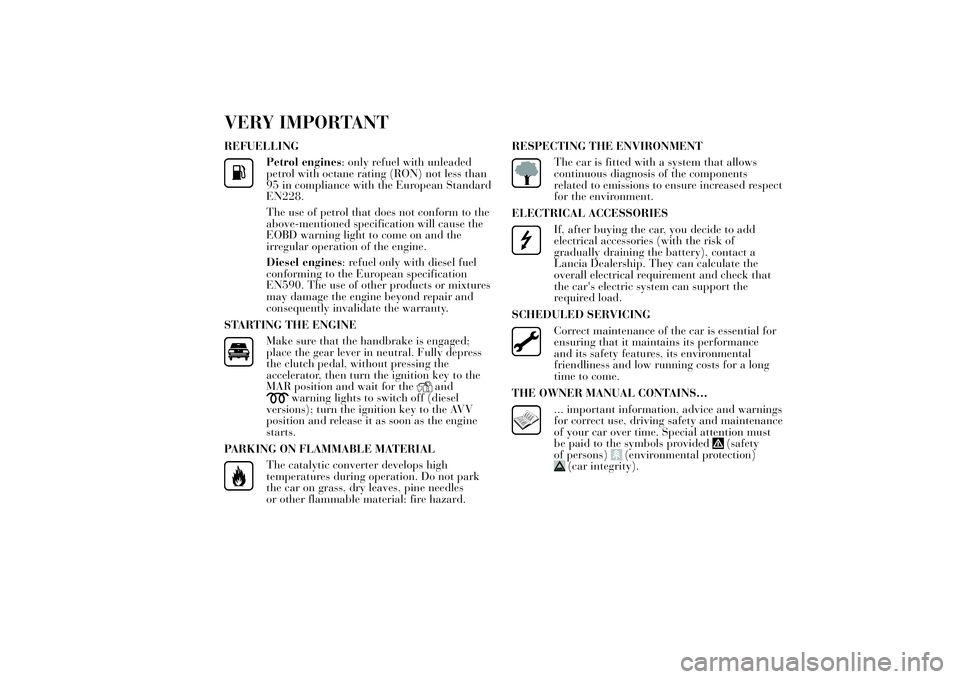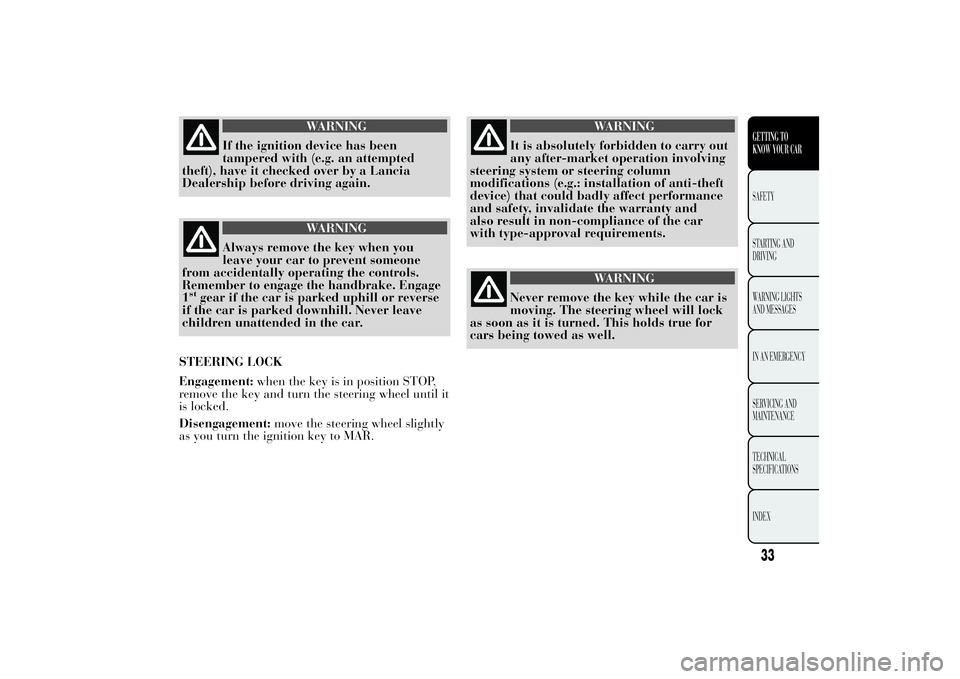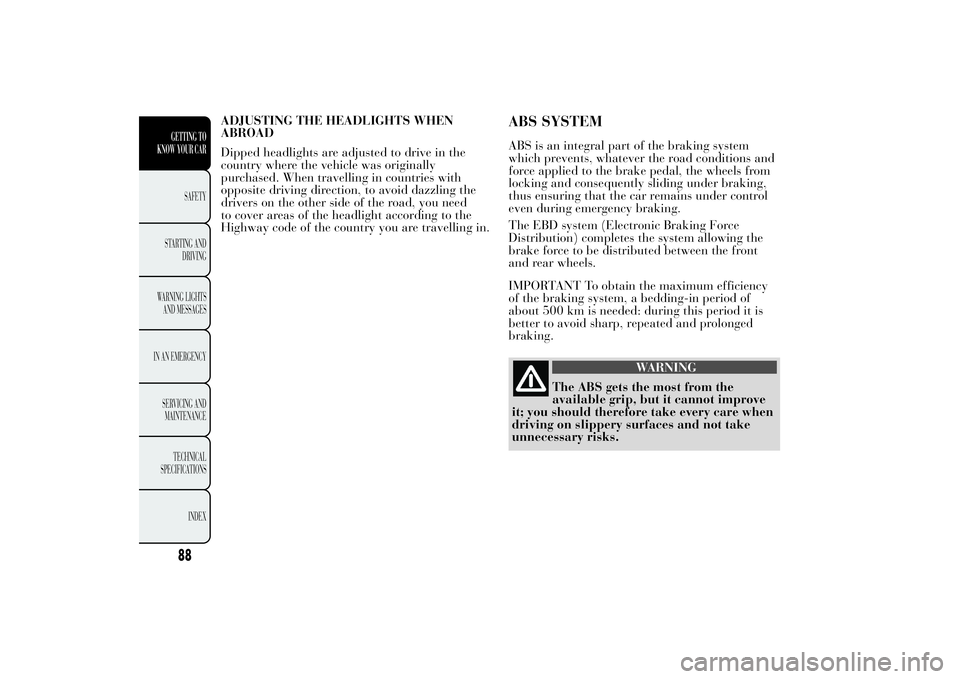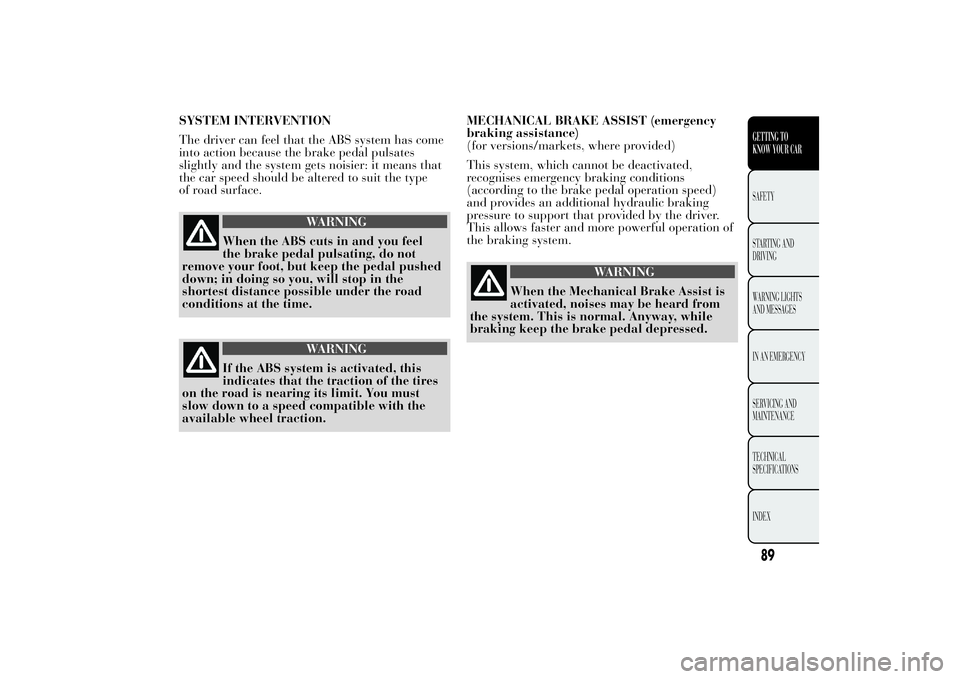brake light Lancia Ypsilon 2012 Owner handbook (in English)
[x] Cancel search | Manufacturer: LANCIA, Model Year: 2012, Model line: Ypsilon, Model: Lancia Ypsilon 2012Pages: 307, PDF Size: 13.3 MB
Page 6 of 307

VERY IMPORTANTREFUELLING
Petrol engines: only refuel with unleaded
petrol with octane rating (RON) not less than
95 in compliance with the European Standard
EN228.
The use of petrol that does not conform to the
above-mentioned specification will cause the
EOBD warning light to come on and the
irregular operation of the engine.
Diesel engines: refuel only with diesel fuel
conforming to the European specification
EN590. The use of other products or mixtures
may damage the engine beyond repair and
consequently invalidate the warranty.
STARTING THE ENGINEMake sure that the handbrake is engaged;
place the gear lever in neutral. Fully depress
the clutch pedal, without pressing the
accelerator, then turn the ignition key to the
MAR position and wait for the
and
warning lights to switch off (diesel
versions); turn the ignition key to the AVV
position and release it as soon as the engine
starts.
PARKING ON FLAMMABLE MATERIAL
The catalytic converter develops high
temperatures during operation. Do not park
the car on grass, dry leaves, pine needles
or other flammable material: fire hazard.RESPECTING THE ENVIRONMENT
The car is fitted with a system that allows
continuous diagnosis of the components
related to emissions to ensure increased respect
for the environment.
ELECTRICAL ACCESSORIESIf, after buying the car, you decide to add
electrical accessories (with the risk of
gradually draining the battery), contact a
Lancia Dealership. They can calculate the
overall electrical requirement and check that
the car's electric system can support the
required load.
SCHEDULED SERVICINGCorrect maintenance of the car is essential for
ensuring that it maintains its performance
and its safety features, its environmental
friendliness and low running costs for a long
time to come.
THE OWNER MANUAL CONTAINS…... important information, advice and warnings
for correct use, driving safety and maintenance
of your car over time. Special attention must
be paid to the symbols provided
(safety
of persons)
(environmental protection)
(car integrity).
Page 35 of 307

WARNING
If the ignition device has been
tampered with (e.g. an attempted
theft), have it checked over by a Lancia
Dealership before driving again.
WARNING
Always remove the key when you
leave your car to prevent someone
from accidentally operating the controls.
Remember to engage the handbrake. Engage
1
stgear if the car is parked uphill or reverse
if the car is parked downhill. Never leave
children unattended in the car.
STEERING LOCK
Engagement:when the key is in position STOP,
remove the key and turn the steering wheel until it
is locked.
Disengagement:move the steering wheel slightly
as you turn the ignition key to MAR.
WARNING
It is absolutely forbidden to carry out
any after-market operation involving
steering system or steering column
modifications (e.g.: installation of anti-theft
device) that could badly affect performance
and safety, invalidate the warranty and
also result in non-compliance of the car
with type-approval requirements.
WARNING
Never remove the key while the car is
moving. The steering wheel will lock
as soon as it is turned. This holds true for
cars being towed as well.
33GETTING TO
KNOW YOUR CARSAFETY
STARTING AND
DRIVING
WARNING LIGHTS
AND MESSAGES
IN AN EMERGENCY
SERVICING AND
MAINTENANCE
TECHNICAL
SPECIFICATIONS
INDEX
Page 64 of 307

Restoring the stored speed
If the device has been deactivated, for example by
depressing the brake or clutch pedal, the stored
speed can be restored as follows:
❒accelerate progressively until a speed close to
that stored is reached;
❒engage the gear selected at the time that the
speed was stored;
❒press the RES button.
Increasing the stored speed
This can be carried out in two ways:
❒by pressing the accelerator and storing the new
speed reached
or
❒by moving the stalk upwards (+).
Each movement of the stalk corresponds to an
increase in speed of about 1 km/h, while keeping
the stalk held upwards will continuously increase
the speed.Decreasing the stored speed
This can be carried out in two ways:
❒by deactivating the device and then storing the
new speed;
or
❒by moving the stalk downwards (-) until the
new speed, which will be stored automatically, is
reached.
Each movement of the lever corresponds to a
reduction in speed of about 1 km/h, while keeping
the stalk held downwards will decrease the speed
continuously.
Deactivating the device
The device can be deactivated by the driver in the
following ways:
❒by turning ring nut A to the OFF position
❒by stopping the engine
❒by pressing the brake pedal, the clutch or the
accelerator; in this last case the system is not
effectively deactivated but gives priority to the
acceleration request. The device still remains
active, without the need to press the RES button
to return to the previous condition once
acceleration is concluded.
62GETTING TO
KNOW YOUR CAR
SAFETY
STARTING AND
DRIVING
WARNING LIGHTS
AND MESSAGES
IN AN EMERGENCY
SERVICING AND
MAINTENANCE
TECHNICAL
SPECIFICATIONS
INDEX
Page 72 of 307

INTERIOR FITTINGSPASSENGER SIDE GLOVE COMPARTMENT
Operate handle A fig. 48 to open the
compartment. When the compartment is opened a
courtesy light switches on.
WARNING
Never travel with the glove
compartment open: it could injure
the passenger in the event of a crash.POWER SOCKET
It is located on the centralfig. 49 near the
handbrake lever. It only operates with the ignition
key at MAR.
IMPORTANT Do not connect devices with power
higher than 180 W to the socket. Do not damage
the socket by using unsuitable adaptors.
fig. 48
L0F0057
fig. 49
L0F0076
70GETTING TO
KNOW YOUR CAR
SAFETY
STARTING AND
DRIVING
WARNING LIGHTS
AND MESSAGES
IN AN EMERGENCY
SERVICING AND
MAINTENANCE
TECHNICAL
SPECIFICATIONS
INDEX
Page 73 of 307

CIGAR LIGHTER
(for versions/markets, where provided)
It is located on the central console next to the
handbrake. Press button A fig. 50 to activate the
cigar lighter.
After a few seconds the button automatically
returns to its initial position, and the cigarette
lighter is ready for use.
IMPORTANT Always check that the cigar lighter
is switched off.
IMPORTANT Do not connect devices with power
higher than 180 W to the socket. Do not damage
the socket by using unsuitable adaptors.
WARNING
The cigar lighter gets very hot.
Handle it carefully and make sure
that children don’t use it: risk of fire and/or
burns.
ASHTRAY
(for versions/markets, where provided)
The ashtray is a removable spring-loaded plastic
container that must be fitted into the right
cup/can holder on the central tunnel fig. 51.
IMPORTANT Do not use the ashtray as a waste
paper basket: it may catch fire in contact with
cigarette stubs.
fig. 50
L0F0258
fig. 51
L0F0056
71GETTING TO
KNOW YOUR CARSAFETY
STARTING AND
DRIVING
WARNING LIGHTS
AND MESSAGES
IN AN EMERGENCY
SERVICING AND
MAINTENANCE
TECHNICAL
SPECIFICATIONS
INDEX
Page 86 of 307

BONNETOPENING
Proceed as follows:
❒pull lever A fig. 65 in the direction indicated by
the arrow;
❒move lever B fig. 66 to the left as shown in the
figure;
❒lift the bonnet and, at the same time, release the
supporting rod C fig. 67 from its catch D, then
insert the end of the rod into housing E in
the bonnet (large hole) and push to safety
position (small hole), as shown in the figure.
WARNING
The bonnet may drop suddenly if the
supporting rod is not positioned
correctly.Use both hands to lift the bonnet.
Before lifting, check that the
windscreen wiper arms are not raised
from the windscreen, that the car is stationary
and that the handbrake is engaged.
fig. 65
L0F0096
fig. 66
L0F0097
84GETTING TO
KNOW YOUR CAR
SAFETY
STARTING AND
DRIVING
WARNING LIGHTS
AND MESSAGES
IN AN EMERGENCY
SERVICING AND
MAINTENANCE
TECHNICAL
SPECIFICATIONS
INDEX
Page 90 of 307

ADJUSTING THE HEADLIGHTS WHEN
ABROAD
Dipped headlights are adjusted to drive in the
country where the vehicle was originally
purchased. When travelling in countries with
opposite driving direction, to avoid dazzling the
drivers on the other side of the road, you need
to cover areas of the headlight according to the
Highway code of the country you are travelling in.
ABS SYSTEMABS is an integral part of the braking system
which prevents, whatever the road conditions and
force applied to the brake pedal, the wheels from
locking and consequently sliding under braking,
thus ensuring that the car remains under control
even during emergency braking.
The EBD system (Electronic Braking Force
Distribution) completes the system allowing the
brake force to be distributed between the front
and rear wheels.
IMPORTANT To obtain the maximum efficiency
of the braking system, a bedding-in period of
about 500 km is needed: during this period it is
better to avoid sharp, repeated and prolonged
braking.
WARNING
The ABS gets the most from the
available grip, but it cannot improve
it; you should therefore take every care when
driving on slippery surfaces and not take
unnecessary risks.
88GETTING TO
KNOW YOUR CAR
SAFETY
STARTING AND
DRIVING
WARNING LIGHTS
AND MESSAGES
IN AN EMERGENCY
SERVICING AND
MAINTENANCE
TECHNICAL
SPECIFICATIONS
INDEX
Page 91 of 307

SYSTEM INTERVENTION
The driver can feel that the ABS system has come
into action because the brake pedal pulsates
slightly and the system gets noisier: it means that
the car speed should be altered to suit the type
of road surface.
WARNING
When the ABS cuts in and you feel
the brake pedal pulsating, do not
remove your foot, but keep the pedal pushed
down; in doing so you, will stop in the
shortest distance possible under the road
conditions at the time.
WARNING
If the ABS system is activated, this
indicates that the traction of the tires
on the road is nearing its limit. You must
slow down to a speed compatible with the
available wheel traction.MECHANICAL BRAKE ASSIST (emergency
braking assistance)
(for versions/markets, where provided)
This system, which cannot be deactivated,
recognises emergency braking conditions
(according to the brake pedal operation speed)
and provides an additional hydraulic braking
pressure to support that provided by the driver.
This allows faster and more powerful operation of
the braking system.
WARNING
When the Mechanical Brake Assist is
activated, noises may be heard from
the system. This is normal. Anyway, while
braking keep the brake pedal depressed.
89GETTING TO
KNOW YOUR CARSAFETY
STARTING AND
DRIVING
WARNING LIGHTS
AND MESSAGES
IN AN EMERGENCY
SERVICING AND
MAINTENANCE
TECHNICAL
SPECIFICATIONS
INDEX
Page 92 of 307

ESC SYSTEM (Electronic Stability
Control)This is an electronic system that controls car
stability in the event of tyre grip loss, helping
maintain directional control. The system is
capable of recognising potentially dangerous
situations in terms of the stability and intervenes
automatically on the brakes in a differentiated
manner for the four wheels in order to provide a
stabilizing torque.
The ESC system also includes the following
subsystems:
❒Hill Holder
❒ASR
❒Brake Assist
❒MSR
❒HBASYSTEM INTERVENTION
It is signalled by the flashing of theESCwarning
light on the instrument panel, to inform the driver
that the car is in critical stability and grip
conditions.
SYSTEM ACTIVATION
The ESC system switches on automatically when
the engine is started and cannot be switched off.
HILL HOLDER SYSTEM
This system is an integral part of the ESC system
and facilitates starting on slopes.
It is activated automatically in the following
instances:
❒uphill: car stationary on a road with a gradient
higher than 5%, engine running, brake pressed
and gearbox in neutral or gear (other than
reverse) engaged;
❒downhill: car stationary on a road with a
gradient higher than 5%, engine running, brake
pressed and reverse gear engaged.
90GETTING TO
KNOW YOUR CAR
SAFETY
STARTING AND
DRIVING
WARNING LIGHTS
AND MESSAGES
IN AN EMERGENCY
SERVICING AND
MAINTENANCE
TECHNICAL
SPECIFICATIONS
INDEX
Page 93 of 307

When setting off, the ESC system control unit
maintains braking pressure on the wheels until the
torque required for starting is reach or, in any
case, for a maximum of 2 seconds so that the right
foot can be moved easily from the brake pedal to
the accelerator pedal.
When 2 seconds have elapsed, without any
departure having taken place, the system is
automatically deactivated, gradually releasing the
braking pressure. During this release stage, a
typical mechanical brake release noise can
be heard, indicating that the car is about to move.
IMPORTANT The Hill Holder system is not a
parking brake, therefore do not leave the vehicle
without activating the handbrake, switching
off the engine and engaging first gear.
ASR SYSTEM (AntiSlip Regulation)
It is an integral part of the ESC system. It
automatically operates in the event of one or both
drive wheels slipping, loss of grip on wet roads
(aquaplaning) and acceleration on slippery, snowy
or icy roads, etc…
Depending on the slipping conditions, two
different control systems are activated:
❒if the slipping involves both drive wheels, the
ASR intervenes reducing the power transmitted
by the engine;
❒if the slipping only involves one of the drive
wheels, it intervenes automatically braking
the wheel that is slipping.Activation/deactivation of the ASR system
The ASR system activates automatically each time
the engine is started.
Whilst driving, the ASR can be deactivated and
subsequently activated again by pressing the ASR
OFF button fig. 70.
On some versions, the intervention of the system is
indicated by a message shown on the display.
When the system is not active, the LED on the
button ASR OFF turns on and, on some versions,
a message appears on the display.
When the ASR is deactivated whilst driving, the
next time the car is started the ASR is
automatically activated.
When travelling on snowy roads with snow chains,
it may be helpful to turn the ASR off: in fact, in
these conditions, slipping of the drive wheels when
moving off makes it possible to obtain better
traction.
fig. 70
L0F0040
91GETTING TO
KNOW YOUR CARSAFETY
STARTING AND
DRIVING
WARNING LIGHTS
AND MESSAGES
IN AN EMERGENCY
SERVICING AND
MAINTENANCE
TECHNICAL
SPECIFICATIONS
INDEX